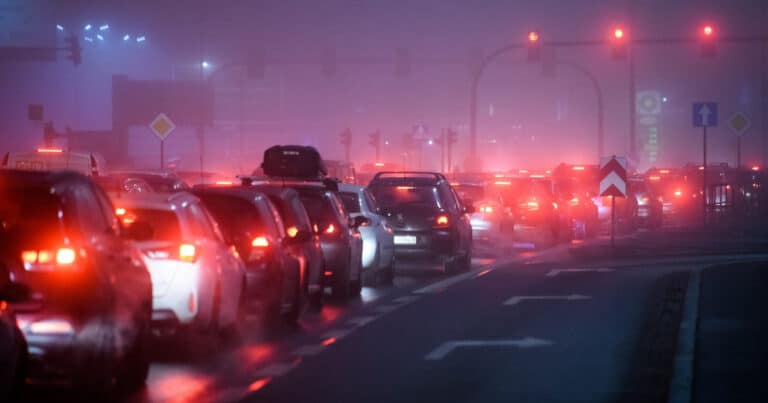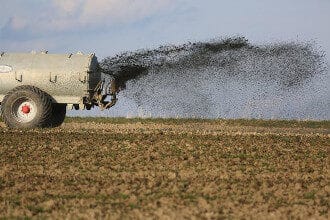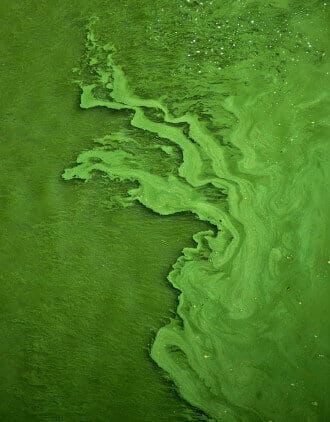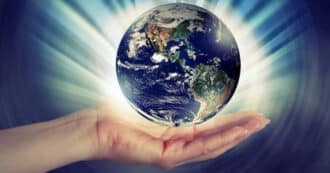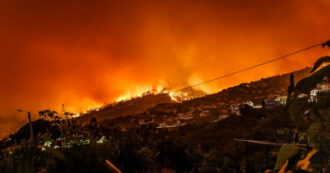By Harry Cooper – Nitrogen, or N2, makes up 80% of our atmosphere. Nitrogen is one of the most common elements on Earth, and is essential for plant growth all over the world.
So if nitrogen is a prominent naturally occurring substance that helps plants grow, how could it be so bad for the environment? The answer lies in reactive nitrogen compounds. These compounds are forms of nitrogen attached to other elements, such as ammonia, nitrous oxide, and nitrate.
The Environmental Impacts of Nitrogen
These reactive nitrogen compounds come from various sources of human activity such as fossil fuel emissions and overuse of chemical fertilizers, which have given us a very large nitrogen footprint. When these nitrogen compounds get into the environment they produce a variety of environmental impacts, everything from killing off wildlife to harming human health.
Nitrogen pollution can occur both in the air and in the water, both with their own unique effects. But regardless of where nitrogen pollution is being released, if we want to protect ourselves and the planet, we need to look for solutions to nitrogen pollution.
Nitrogen Pollution in the Air
Nitrogen air pollution is a result of nitrogen based greenhouse gas emissions. These emissions are responsible for everything from acid rain to increased respiratory diseases.
Nitrogen Dioxide
Nitrogen dioxide is the specific type of reactive nitrogen compound and potent greenhouse gas that causes nitrogen based air pollution. This chemical comes almost exclusively from sources that burn fossil fuels, such as cars, trucks, buses, power plants, diesel powered machinery, and other engine based equipment.
With all the fossil fuels we burn, we emit a massive amount of carbon dioxide and nitrogen dioxide; it is estimated that the US can emit up to 14 million metric tons of nitrogen dioxide in a year.
These emissions are primarily located in dense cities and over busy roads. However, indoor nitrogen pollution can also be an issue for houses with gas stoves or gas heaters. These emit considerable amounts of nitrogen dioxide, and can create harmful indoor air pollution.
Health Affects of Nitrogen Dioxide
Nitrogen dioxide emissions are incredibly dangerous for public health. These affects can be short term or long term, but any amount of over exposure could have serious human health costs.
Short Term Effects
Short term exposure to nitrogen dioxide emissions causes irritation in the respiratory system. This can lead to coughing, labored breathing, and wheezing. While these may not seem too serious, people with pre-existing respiratory diseases such as asthma, could end up being hospitalized, even as a result of short term exposure.
Long Term Effects
Long term exposure can end up causing respiratory diseases, such as asthma and respiratory infections. While everyone is at risk of developing these medical conditions, children and the elderly are known to be at greater risk.
If we do not decrease nitrogen pollution, these health impacts will become even worse. It is even more concerning when we look at the fact that nitrogen dioxide is so prevalent in our society. Cars and other vehicles are constantly filling our cities with this toxic gas, and thanks to indoor air pollution from gas based appliances, we may not even be safe from it in our own homes.
Acid Rain
Reactive nitrogen compounds are also in part responsible for another environmentally devastating phenomenon, acid rain. One of the main ingredients of acid rain is nitrous oxide emissions.
When these nitrous oxide emissions mix with water vapor in the air they form water particles that are inherently more acidic than normal. These acidic water particles eventually form clouds and fall to the ground as acid rain. Acid rain can have some serious environmental consequences. When it falls into water bodies, it can kill off marine animals that aren’t used to such high levels of acidity.
When acid rain falls over land it can have some devastating impacts on plant life and soil quality. Acid rain has been known to devastate forests, sometimes only leaving behind blackened trees with limbs stripped of leaves. Acid rain also throws off the pH balance of soils. While the soil in some places is capable of recovering, many places have become much less capable of supporting plant life due to increased acidity in the soil.
Nitrogen Pollution in the Water
Excess nitrogen can also have devastating effects on marine life and environments when it gets into bodies of water. While air based nitrogen pollution comes from nitrogen gas emissions, nitrogen pollution in our world’s water supplies comes mainly from synthetic nitrogen fertilizers used in agriculture and food production.
Nitrogen and Agriculture
In order to improve crop yields many farmers use nitrogen and phosphorus based fertilisers. While these fertilisers help produce more food, when it rains the nitrogen in these synthetic nitrogen fertilisers gets into rain water run off and eventually finds its way into bodies of water and marine environments.
The amount of nitrogen pollution released due to the use of chemical fertilisers is massive, but by using more environmentally conscious fertilising techniques, farmers can help to reduce nitrogen runoff. By using fertilisers in moderation and only at certain times of the year farmers can reduce nitrogen pollution that is produced by their farms.
Farmers can also plant cover crops in off seasons and plant trees and shrubs around the edges of their fields. These types of plants are capable of absorbing and preventing run off water. This lets the farms take up the nitrogen that would go to polluting our water systems.
The Effects of Nitrogen Pollution in Water
While farmers are capable of reducing their nitrogen footprint, the agricultural industry as a whole is still responsible for massive amounts of nitrogen ending up in bodies of water throughout the world. This excess nitrogen has a lot of big impacts on marine life and human health, the most notable one being eutrophication.
Eutrophication
Eutrophication is the process by which excessive nutrients, such as synthetic nitrogen fertilisers make marine environments unsuitable for life. And thanks to the huge amount of nitrogen used in our agriculture industry, more and more places are undergoing eutrophication every day.
Eutrophication starts when the excess nitrogen enters a lake, pond, or coastal ecosystem. The extra nutrients allow for large population explosions of algae called algal blooms.
These algal blooms fill the water with all kinds of algae and phytoplankton. When these algal blooms die they sink to the bottom of the water. There, other microorganisms begin to decompose the giant algal blooms. This process of decomposition uses up large amounts of oxygen. When big enough algal blooms die they can entirely deplete the water of oxygen, creating an anaerobic or hypoxic environment called a dead zone.
It is almost impossible for anything to survive when nitrogen pollution creates these dead zones. Sometimes these dead zones can take up entire swaths of coastline, killing hundreds of plants and animals.
Eutrophication and Human Health
Eutrophication and nitrogen pollution are capable of killing off large amounts of marine plants and animals and making large areas of water unlivable. Along with this, eutrophication can have some serious affects on human health.
Most of the human health risks of eutrophication come from the different types of algae blooms that occur when water becomes nitrogen polluted. Many of the different kinds of algae that occur at nitrogen pollution sites are incredibly toxic to humans, and many places have had to ban humans from coming into contact with eutrophicated water.
One of the more notorious algae species associated with eutrophication is the red tide algae, named after its abilities to turn entire coastlines a rusty red color. Red tide algae produces powerful neurotoxins that poison the animals that eat them. Many coastlines that were once popular for catching shellfish and crustaceans have now been closed off, as when humans ingest these infected shellfish they can become exposed to the neurotoxins produced by the red tide.
Another dangerous algae that can result from eutrophication is blue green algae. Blue green algae is one of the more toxic types of algae that poisons wildlife, pets, livestock, and humans, whenever they come into contact with it. When blue green algal blooms arise in a body of water, there is no choice but to prevent anyone from coming into contact with the water.
Religion and Nitrogen Pollution
An article in America: The Jesuit Review describes how a “plant-based diet can help us meet Pope Francis’ ‘Laudato Si’ challenge.'” Mary E. McGann, the author, writes about how consuming less animal products can help us protect the water from nitrogen pollution. She describes how “phosphorus and nitrogen pollution, which is released in high volumes by slaughterhouses, has created a huge ‘dead zone’ in the Gulf of Mexico, larger than the size of Connecticut, which strips the water of oxygen, forcing fish to flee or suffocate.” Reducing our consumption of industrial meat and supporting farmers who are sustainably growing grass-fed cattle is a great way to combat climate change and live in sync with our religious values.
God only gave us one planet, let’s do everything we can to protect it.
* Featured image source

